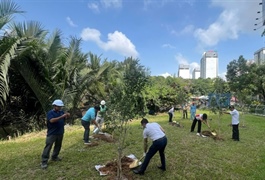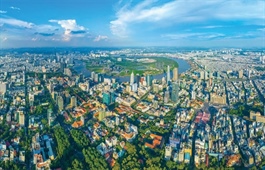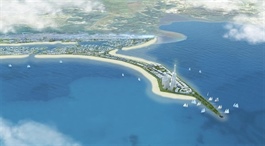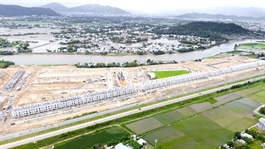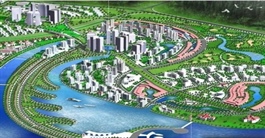Infrastructure boom drives real estate market growth
Infrastructure boom drives real estate market growth
The remarkable development in transport infrastructure is driving the takeoff of the real estate market in Vietnam. On April 19 alone, a raft of key undertakings were kicked off across the country.
Vingroup broke ground on the Vinhomes Green Paradise coastal urban tourism initiative in Can Gio district of Ho Chi Minh City. According to the developer, Vinhomes Green Paradise will cost $18 billion, span 2,870 hectares, and accommodate up to 230,000 people.
On the same day, Hanoi commenced construction of an intersection between Ring Road 3.5 and Thang Long Boulevard in Hoai Duc district, with a total investment of nearly $100 million.
Meanwhile, Thanh Hoa People’s Committee began the second phase of Nam Song Ma Avenue, which extends from Quang Hung ward to the end of Quang Tam ward. The 5.6km undertaking is expected to be completed by the end of 2026.
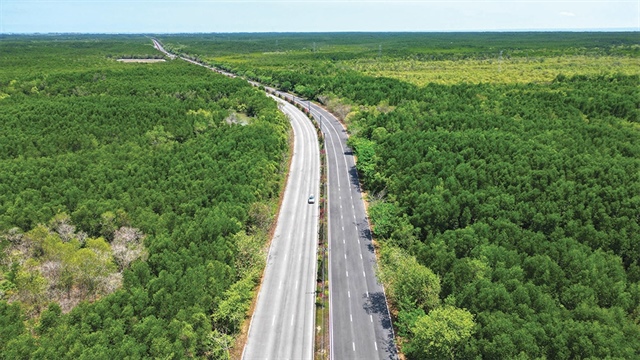
Infrastructure boom drives real estate market growth |
Construction of the T2 terminal at Dong Hoi Airport in the central province of Quang Binh also started, with a total investment of $70 million. The initiative, led by Vietnam Airports Corporation, involves the construction of a terminal spanning 12,000sq.m, parking spaces and green areas. The T2 terminal, designed to handle three million domestic passengers per year, is expected to be operational by the end of this year.
According to the Ministry of Construction, with the goal of completing construction of 3,000km of expressways by the end of 2025, major projects such as the North-South Expressway, another route connecting the eastern and southwestern regions, and key routes linking the northwest and Central Highlands are being implemented.
This ministry, together with local authorities and the Vietnam Expressway Investment and Development Corporation, are implementing 28 projects that seek to be completed by the end of 2025. By 2030, the total length of expressways in Vietnam will reach 5,000km.
In Ho Chi Minh City, metro line 1 from Ben Thanh to Suoi Tien began commercial operations at the end of December 2024. Additionally, the Thu Thiem area in Thu Duc city is emerging as a new urban development centre, with important infrastructure projects such as bridges and tunnels.
The Thu Thiem pedestrian bridge started construction in April, and other bridges connecting to districts 4 and 7 are in the pipeline. The 48-km metro line 2 from Ben Thanh to Tham Luong is also expected to start construction at the end of 2025 and be completed in 2030.
In the southern province of Dong Nai, the Xuan Que-Song Nhan Industrial Park is benefiting from infrastructure development, thanks to its location near major projects like the North-South Expressway and upcoming Long Thanh International Airport.
According to Avison Young’s forecast, in 2025, Ho Chi Minh City will have about 50,000 apartments from 17 new projects.
Some notable projects to be launched include the Masteri Grand View tower complex in Global City, developed by Masterise Homes, King Crown Infinity by BCG Land, and The Gio Riverside by An Gia Group.
Sales are expected to rise due to investment and asset accumulation demand. Furthermore, improvements in transport infrastructure will provide strong momentum to support demand for residential projects in Ho Chi Minh City and surrounding areas.
Duong Tong, a real estate broker, stated that since the beginning of the year, the number of customers purchasing apartments in Ho Chi Minh City, Dong Nai, and Binh Duong has been increasing, and liquidity is very promising.
“This prospects will be clearer when the Metro Line 1 extending from Suoi Tien in Ho Chi Minh City to Binh Duong New City, is expected to begin construction in 2027 and be operational in 2031,” Tong said. “The quick connectivity between Ho Chi Minh City and Binh Duong, combined with the commercial potential from transport infrastructure, promises significant price increases for real estate in the region.”
As infrastructure continues to develop rapidly, areas surrounding major projects such as the Long Thanh Internatonal Airport in Dong Nai province, Thu Thiem Bridge, and Ring Road 3 of Ho Chi Minh City are attracting the attention of investors and homebuyers.
These areas are becoming hotspots, contributing to the growing demand for real estate, from residential properties to commercial, industrial, and resort projects.
According to Hoang Hung, a real estate broker in Ho Chi Minh City, in addition to increasing real estate value, the modernisation of transport infrastructure also attracts investors and residents to move to suburban areas.
“Developed infrastructure helps expand urban space, alleviating pressure on the city centre. Areas once considered far from the centre, such as Dong Anh and Hoai Duc in Hanoi, Cu Chi and Nha Be in Ho Chi Minh City, or neighbouring areas like Binh Duong and Dong Nai, are now becoming hotspots due to better connections,” Hung said.
Moreover, infrastructure development leads to population movement, increasing demand for housing. Many urban areas have been invested along new routes, particularly fuelling the trend of real estate investment anticipating infrastructure development, he added.
|
Assoc. Prof. Dr. Tran Dinh Thien Former director Vietnam Institute of Economics Can Gio, a remote district of Ho Chi Minh City, has long been considered one of the most disadvantaged and distant areas of the city. However, with the launch of the coastal mega tourism urban a port, a metro line, and a bridge, Can Gio is proving its potential for a significant transformation. Strategically located on the vital waterway route from the East Sea to Ho Chi Minh City, Can Gio boasts numerous advantages in marine economy, ecotourism, and renewable energy. These factors are key to promoting sustainable development while also ensuring national defence and security. However, for many years, Can Gio has been viewed as a remote and less-developed region of the city. The idea of transforming Can Gio into an ecotourism and leisure urban area has been envisioned for over 30 years and has now been concretised in Ho Chi Minh City’s development plan towards 2030 and beyond. The launching of the Can Gio coastal tourism urban project by Vingroup in April marks the first step in this major change. The need for a coastal urban area in Can Gio is not a new concept. Decades ago, Ho Chi Minh City had plans to develop along the coast, but these plans were never realise due to the lack of connectivity between the island and the city centre. As the country’s largest economic engine and a special urban area, Ho Chi Minh City requires a maritime-focused development strategy, especially as the city explores regional integration with Binh Duong and Ba Ria-Vung Tau provinces. The construction of the coastal tourism urban area and many other infrastructure ventures in Can Gio will not only boost Ho Chi Minh City’s development, but also have a broader impact nationwide. They will become driving forces, propelling the southern coastline towards modernity, integration, and high-tech applications. Can Gio will become a hub for attracting human, financial, and technological resources. This is not just a standalone project, it is a strategic national undertaking. It will also benefit from other large-scale programmes currently being implemented in Ho Chi Minh City, forming a powerful and comprehensive development cluster. Moreover, it demonstrates the critical role of the private economic sector in driving growth. It can be seen as a source of national pride and affirms the correctness of the Party and state’s strategy of placing trust in the private sector to accelerate economic development. However, to enable the private sector to fully realise its potential, conducive mechanisms, powers, and development space must be created. |
|
80 key infrastructure projects launched nationwide to mark 50 years since reunification On April 19 at the newly launched Terminal T3 of Tan Son Nhat International Airport in Ho Chi Minh City, Prime Minister Pham Minh Chinh presided over the groundbreaking and inauguration ceremony of major national projects and key infrastructure works in celebration of 50 years since national reunification. Participating at various sites across the country were former Politburo members, high ranking officials, and local authorities. The ceremony was conducted in both in-person and online formats, simultaneously connecting across all three main regions, from the main site in Ho Chi Minh City to each of the project locations. According to ministries, sectors, and local authorities, 80 projects are being launched or inaugurated during this occasion, with a total investment of approximately $17.8 billion. Of this, $12.2 billion is allocated for new groundbreaking projects, and $5.6 million for completed projects. State budget contributions amount to $7.4 million, while $10.4 million comes from non-budgetary sources. These include 40 transport infrastructure projects, 12 industrial and civil construction projects, 12 education projects, nine socio-cultural initiatives, five public health projects, and two irrigation works. In his address, PM Chinh, invoking the spirit of speed and boldness from the historic April days of 1975, officially declared the commencement and completion of the nationally significant and strategic projects led by both central and local governments, to be realised in 2025. |
- 17:00 02/05/2025




